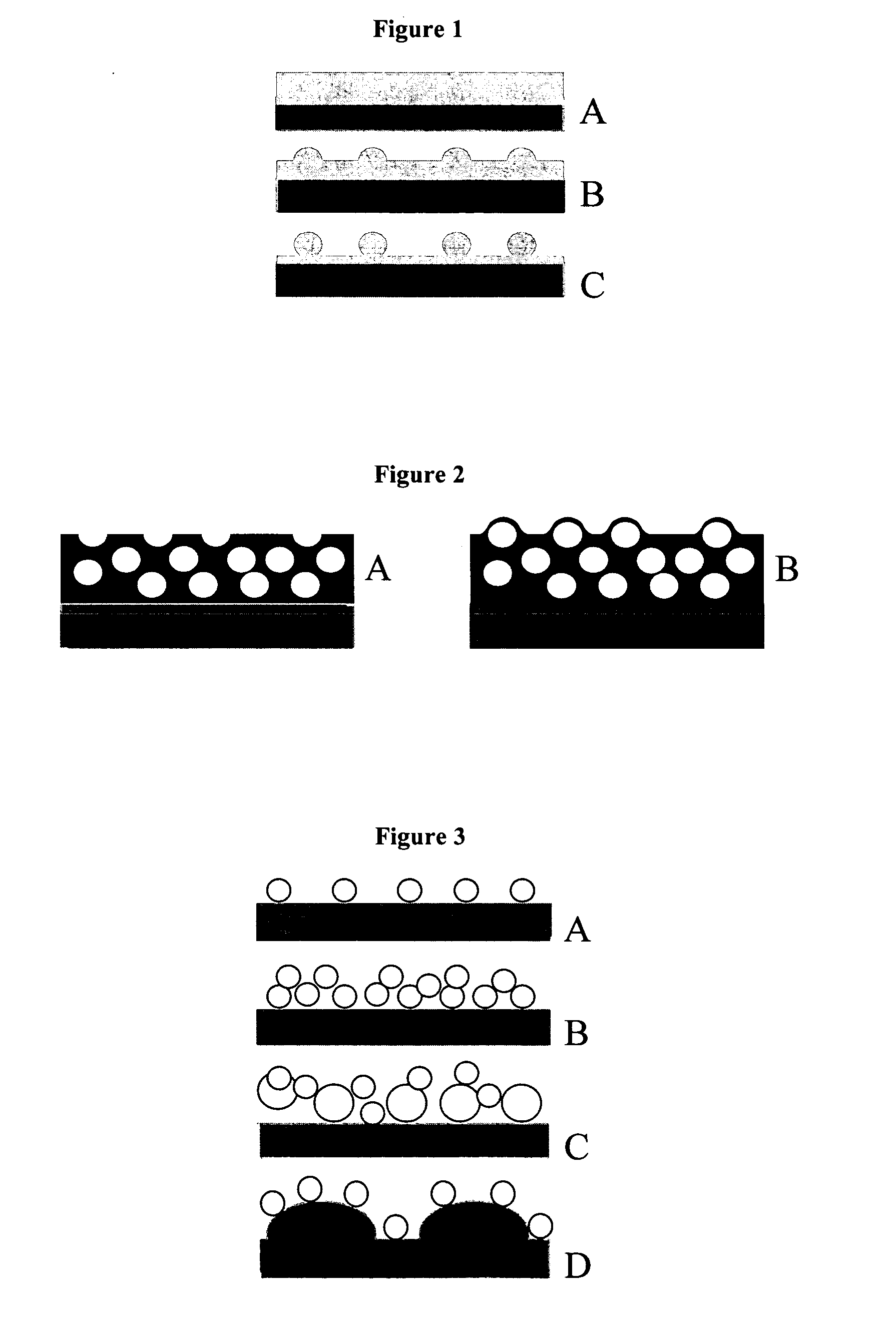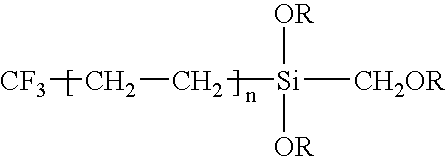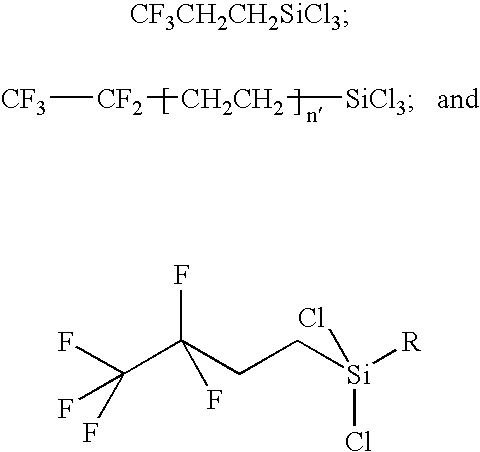Article coated with an ultra high hydrophobic film and process for obtaining same
a technology of hydrophobic film and coating, applied in the field of articles, can solve the problems of commercial coatings or substrates that are easily soiled, difficult to clean, and residues that can be detrimental to the original properties or performances, and achieve the effect of low energy surfa
- Summary
- Abstract
- Description
- Claims
- Application Information
AI Technical Summary
Benefits of technology
Problems solved by technology
Method used
Image
Examples
example 1
[0161]Polyethyleneimide (PEI) aqueous solution (0.02 M, pH=5-7) was used as a binder to bond nanoparticles through electrostatic interactions. Three types of SiO2 nanoparticle aqueous solutions (5-10 wt %) were used, including 10-15 nm particles (SiO2A), 40-50 nm particles (SiO2B), and 100 nm particles (SiO2C).
[0162]An Airwear™ Essilor lens substrate was first corona-treated. Then the substrate was dipped into a PEI binder solution for 5 minutes (step b1), and rinsed with deionized water. The resulting coated substrate was then dipped into a nanoparticle solution for 5 minutes (step b2), and rinsed with deionized water, allowing obtaining one (sub-)layer of nanoparticles. If necessary, steps b1), b2) were repeated after initial step b2) to form additional sub-layers of nanoparticles. The film was dried with air, followed with a pre-cure process at 80° C. for 5 minutes and post-cure at 100° C. for 3 hours (step b3). Then, a fluorinated topcoat (Optool DSX) was applied by dip coating ...
example 2
[0166]The article used was an Airwear™ Essilor lens substrate, in which a moth-eye nanostructure (˜250 nm pitch) has been molded. That substrate was coated as described in example 1, using SiO2B nanoparticles in step b2.
[0167]The static water and oleic acid contact angle data are summarized in Table 3. Compared to the commercial control lens onto which a standard smooth top coat is applied, the nanostructured film allowed to dramatically increasing both water and oleic acid contact angles, to almost “super hydrophobicity” and “super oleophobicity”. An apparent decrease in surface energy was also noted, compared to the control lens. However, the nanostructured film of example 2 did not have good adhesion to the substrate because of the nature of the binder.
TABLE 3Static contact angle with:Control lens*Example 2Water110145Oleic acid7498*Commercial PC Airwear ™ lens coated with a commercial Alizé top coat.
example 3
[0168]The same protocol as that of example 1 was repeated using a binder solution comprising 1-1.25 wt % of hydrolyzed Glymo, which is a binder capable of establishing covalent bonds with the nanoparticles and the surface of the substrate. When such a binder film was applied to above SiO2B / SiO2A / SiO2B or SiO2C systems, the surface topography is described as FIG. 1B. Table 4 shows that the prepared articles with WCA ranging from 123 to 135° present good adhesion, high contact angle and low haze, especially the SiO2B / SiO2A / SiO2B system, which maintained such performance after abrasion tests. An apparent decrease in surface energy was observed, compared to the control lens.
TABLE 4CoatedAdhesionExamplearticlesT %HazeWCAtestHaze**WCA**Com-Control92.40.1111000.20110parative 1lens*3.1SiO2B / 94.10.1812300.44120SiO2A / SiO2B3.2SiO2C94.20.3712600.41124*Commercial PC Airwear ™ lens coated with a commercial Alizé top coat.**Those measurements were performed after abrasion tests.
PUM
| Property | Measurement | Unit |
|---|---|---|
| Fraction | aaaaa | aaaaa |
| Fraction | aaaaa | aaaaa |
| Percent by mass | aaaaa | aaaaa |
Abstract
Description
Claims
Application Information
 Login to View More
Login to View More - R&D
- Intellectual Property
- Life Sciences
- Materials
- Tech Scout
- Unparalleled Data Quality
- Higher Quality Content
- 60% Fewer Hallucinations
Browse by: Latest US Patents, China's latest patents, Technical Efficacy Thesaurus, Application Domain, Technology Topic, Popular Technical Reports.
© 2025 PatSnap. All rights reserved.Legal|Privacy policy|Modern Slavery Act Transparency Statement|Sitemap|About US| Contact US: help@patsnap.com



